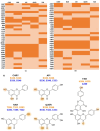Differential Interactions of Flavonoids with the Aryl Hydrocarbon Receptor In Silico and Their Impact on Receptor Activity In Vitro
- PMID: 39204085
- PMCID: PMC11356971
- DOI: 10.3390/ph17080980
Differential Interactions of Flavonoids with the Aryl Hydrocarbon Receptor In Silico and Their Impact on Receptor Activity In Vitro
Abstract
The molecular mechanisms underlying the observed anticancer effects of flavonoids remain unclear. Increasing evidence shows that the aryl hydrocarbon receptor (AHR) plays a crucial role in neoplastic disease progression, establishing it as a potential drug target. This study evaluated the potential of hydroxy flavonoids, known for their anticancer properties, to interact with AHR, both in silico and in vitro, aiming to understand the mechanisms of action and identify selective AHR modulators. A PAS-B domain homology model was constructed to evaluate in silico interactions of chrysin, naringenin, quercetin apigenin and agathisflavone. The EROD activity assay measured the effects of flavonoids on AHR's activity in human breast cancer cells (MCF7). Simulations showed that chrysin, apigenin, naringenin, and quercetin have the highest AHR binding affinity scores (-13.14 to -15.31), while agathisflavone showed low scores (-0.57 and -5.14). All tested flavonoids had the potential to inhibit AHR activity in a dose-dependent manner in the presence of an agonist (TCDD) in vitro. This study elucidates the distinct modulatory effects of flavonoids on AHR, emphasizing naringenin's newly described antagonistic potential. It underscores the importance of understanding flavonoid's molecular mechanisms, which is crucial for developing novel cancer therapies based on these molecules.
Keywords: AHR; TCDD; antagonist; cancer therapy; naringenin; polyphenols.
Conflict of interest statement
The authors declare no conflicts of interest.
Figures



Similar articles
-
Flavonoids as aryl hydrocarbon receptor agonists/antagonists: effects of structure and cell context.Environ Health Perspect. 2003 Dec;111(16):1877-82. doi: 10.1289/ehp.6322. Environ Health Perspect. 2003. PMID: 14644660 Free PMC article.
-
In Silico and In Vitro multiple analysis approach for screening naturally derived ligands for red seabream aryl hydrocarbon receptor.Ecotoxicol Environ Saf. 2024 Apr 15;275:116262. doi: 10.1016/j.ecoenv.2024.116262. Epub 2024 Apr 3. Ecotoxicol Environ Saf. 2024. PMID: 38569320
-
Influence of food polyphenols on aryl hydrocarbon receptor-signaling pathway estimated by in vitro bioassay.Phytochemistry. 2008 Dec;69(18):3117-30. doi: 10.1016/j.phytochem.2007.07.022. Epub 2007 Sep 14. Phytochemistry. 2008. PMID: 17869316 Review.
-
In vitro differential responses of rat and human aryl hydrocarbon receptor to two distinct ligands and to different polyphenols.Environ Pollut. 2020 Oct;265(Pt B):114966. doi: 10.1016/j.envpol.2020.114966. Epub 2020 Jun 10. Environ Pollut. 2020. PMID: 32563119
-
Plant Occurring Flavonoids as Modulators of the Aryl Hydrocarbon Receptor.Molecules. 2021 Apr 16;26(8):2315. doi: 10.3390/molecules26082315. Molecules. 2021. PMID: 33923487 Free PMC article. Review.
Cited by
-
Naringenin Exhibits Antiglioma Activity Related to Aryl Hydrocarbon Receptor Activity and IL-6, CCL2, and TNF-α Expression.Brain Sci. 2025 Mar 20;15(3):325. doi: 10.3390/brainsci15030325. Brain Sci. 2025. PMID: 40149846 Free PMC article.
References
Grants and funding
LinkOut - more resources
Full Text Sources

